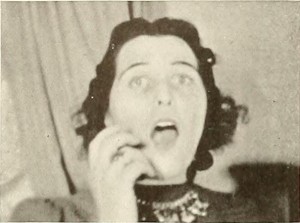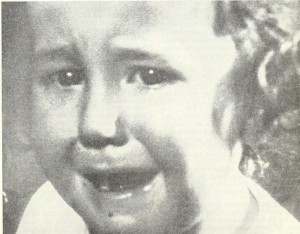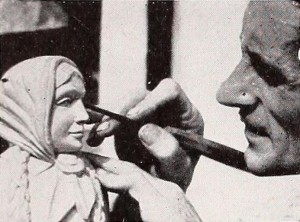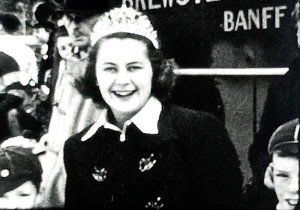"Celebrate the wedding of Amy Norman, visit Belle Vue Zoo,and meet the Powell family, with their own animals, in their garden. A view of Manchester Central Library and the Town Hall Complex precedes cricketing scenes at Bowdon, and finally, a family trip (in colour) to Nefyn in North Wales, where young and old alike enjoy the sun and sea. The Powell family lived in East Didsbury in South Manchester.Manchester Central Library was quite new when this film was shot. It was opened in 1934 by George V, and in 2014 re-opened after refurbishment for its 80th anniversary." (BFI Player)

"When Ernest Kremer wanted to make a film which would include his family and, at the same time, be entertaining to outsiders, he devised An Anaesthetic Fantasy, an ingenious tale of the nightmare of a dental patient under laughing gas. The patient imagines that he returns home, and there things begin to happen that confound him and the audience, too. Clever trick work, dissolves and stop motion are used to create this section of the film. Mr. Kremer has proved that the 8mm. worker need not bow to his 16mm. brothers when it comes to producing cine illusions. The film was presented with a delightfully appropriate selection of musical records played on a dual turntable outfit." Movie Makers, Dec. 1940, 601-602.
"This proved to be an unusual serio-comedy, telling of a restless young husband and how he was cured. It was very well acted by Alfred Fontana as the husband, Margaret Ervin as the vamp, Anne Howe, and Beatrice Traendly as the wife. The directon of Russell T. Ervin Jr. was remarkably good, revealing an unusual facility for telling a story concisely and quickly. Then too, he understood how to cover any histrionic imperfections of his cast. 'And How!' is a suprisingly neat amateur film" Photoplay, June. 1928, 66

"Another Happy Day" was the winner in the home movie classification, the prize going to T. Lawrenson of Dundee, Scotland. Mr. Lawrenson is a member of the Institute of Amateur Cinematographers of London. Also is he a veteran of the American Cinematographer's contests, having been one of the three major prize winners of 1935. Also is the chief actor in the home movie a veteran, a child who now has reached seemingly the mature age of four years, and who of course was but two when he made his debut on the home movie stage in 'Happy Day.' He is a black-eyed, camera-unconscious and personable youngster, who proceeds on his lawful occasions in complete indifference to a live lens." American Cinematographer, Jan. 1938, 27.
"Un-staged documentary footage shot and edited by Sallie Wagner. Sallie's description of the film: 'Shorty Boys, Little Shorty building a hogan, Crip Chee and his hogan, grandson in doorway. Blackrock in front of hogan, Tchindi, Rose Martin doing laundry, cooking shelter at squaw dance, Hosteen Glish getting water, Bent Knee getting wood, Hosteen Glish making a canoe out of a log, Hosteen Glish's granddaughter weaving, digging yucca root for soap, Navajo washing her hair, Hosteen Glish making a cradle board'." New Mexico State Archives.
"As We Forgive, produced by the Religious Motion Picture Foundation and filmed by Kenneth F. Space, with the technical assistance of Dan Lindsay, is a fine example of weaving the theme of the picture into the very warp and woof of its photographic material. The makers of this photoplay had a sincere and simple theme to present, and the excellence of their presentation lay in the fact that every detail of the handling, both in technique and continuity, was done sincerely and simply. It is this carefully worked out unity of treatment with theme that enables the film to serve as a model for producers of photoplays with a message. The filmers particularly are to be congratulated on their handling of child actors, one of the most difficult problems to be solved successfully in any field of the drama. From the technical point of view, we may remark the well exposed interiors, in which the lighting was carefully planned to give the effect of normal illumination; the fine photographic quality displayed in the closeups and camera angles and the smooth unity of the entire technical handling." Movie Makers, Dec. 1936, 542.
"At the Sandpits is perhaps Crawley's first completed work, produced when he was a teenager; Crawley went on to make many award-winning amateur films before turning professional in the 1940s as a producer of industrial films. Employing rapid cutting, trick photography, and imaginative scenarios, At the Sandpits conveys a strong sense of dynamic action in a short film about a family picnic. The film begins by showing the preparation of sandwiches for a picnic; after showing the meal in a few deft shots, the adults are seen relaxing, while the kids and pets, shot from extreme low angle in slow motion, run toward the sandpits. The film continues with short but carefully constructed sequences of the kids pretending to be buried alive in the sand, having a baseball game, and then returning home, tired. Finally, the film concludes with a strange dream sequence, employing trick photography, in which three girls appear decapitated behind a sheet" Tepperman, 173.
"Various family members are seen in the garden of a large house, possibly The Beeches. A woman and baby sit on a blanket in the middle of the lawn. A uniformed nanny joins them with another baby. Concludes with a shot of the two babies together on the blanket" (NWFA Online Database).

"Nine times a place winner in seven years of Ten Best competition, Frank E. Gunnell has probably done his best work to date in Baie St. Paul. The film is a bright and sunny visit to the little French Canadian parish of that name, nestling in parochial contentment along the St. Lawrence. Central in this existence stands the baroque and inevitable church, while about it one finds the familiar family names of the village butcher and baker, doctor and dressmaker, recurrent along the cobbled highways. Here too is an intent, sharp featured little woodcarver, a housewife coolly competent about her embroidery and an aloof mademoiselle who presides with dazzling beauty over an ancient spinning wheel. Packed with this essential human interest, Baie St. Paul was filmed with the sparkling competence that one has for years expected from a Gunnell production. Its editing fits shrewdly into the pastoral mood of the subject matter, while its titles, both in their wording and execution, are colorful and in good taste. Baie St. Paul should take a high and honored place in the Gunnell catalog of fine films." Movie Makers, Dec. 1944, 477.

Chronicle of 1939 Banff Winter carnival, including views of Main Street of Banff, ice castle, carnival queen, figure skating, skiing and ski jumping.
Total Pages: 29